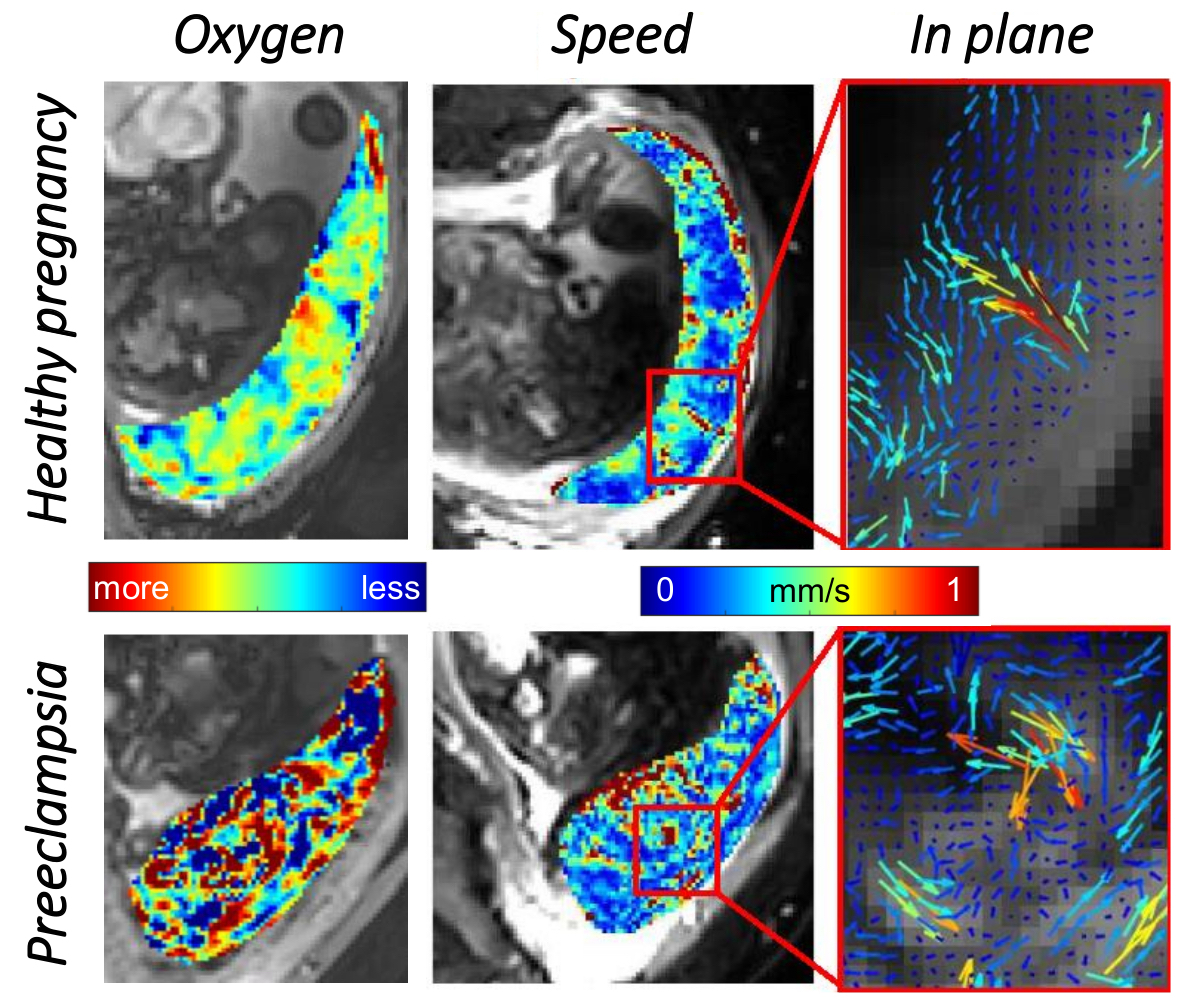Thursday, 28 May 2020
MRI research has revealed detailed new insights into how the placenta works in pregnancy and discovered a completely new phenomenon where the placenta contracts every now and then, a pheonomenon the research team have named the ‘uteroplacental pump’.
Using the very latest wide-bore magnetic resonance imaging (MRI) scanning equipment at the University of Nottingham, experts in the School of Physics and Astronomy, School of Medicine and the School of Life Sciences imaged differences in blood flow through the placenta in healthy and pre-eclampsia pregnancies, a finding which could help understand why in pre-eclampsia the baby can be born small and pre-term.
 Dr Neele Dellschaft, School of Physics and Astronomy
Dr Neele Dellschaft, School of Physics and Astronomy
The research published in PLOS Biology also identified a completely new phenomenon which the researchers have termed the ‘uteroplacental pump’. This involves contractions of placenta and the part of the uterine wall to which it is attached.
The placenta is vital in the transfer of the right amount of nutrition and oxygen from the mother to the baby. Any disturbance to the flow of blood could affect the delivery of vital nutrients restricting fetal growth. If the placenta is not working properly this can lead to pre-eclampsia.
In the placenta the fetal blood flows in tree-like villi which are bathed in a lake of the mother’s blood, so that the two different blood supplies are kept separate. Changes in blood flow and oxygenation affects fetal growth and well-being.
Unprecedented insight
The research team scanned 34 women with healthy pregnancies and 13 women diagnosed with preeclampsia, gaining an unprecedented insight how the maternal blood percolates between the villi and how this affects placental oxygenation.
 Shows the information on blood oxygen and speed of blood movement within the placenta for both a healthy pregnancy (top) and a preeclamptic pregnancy (bottom)
Shows the information on blood oxygen and speed of blood movement within the placenta for both a healthy pregnancy (top) and a preeclamptic pregnancy (bottom)
“I am part of a team of scientists who have used MRI to look at how blood flows through the placenta to deliver oxygen to the baby. We found that in healthy pregnancies maternal blood flows very slowly. This seems odd at first but our other measurements suggest that this is a way in which the baby can pick up nutrients and oxygen efficiently. We also found that the normal patterns of flow and oxygenation were much more variable in pre eclampsia, which can help explain why babies of pre-eclamptic pregnancies tend to be smaller and often have to be delivered before term.
Most excitingly, we also identified a completely new phenomenon which we called the ‘uteroplacental pump’. This is a contraction of the placenta and the part of the uterine wall to which it is attached, and it is not the same as the well-known Braxton Hicks contractions in which the entire uterus contracts in practice for labour. We now want to work out the purpose of these contractions but we think it might be to stop blood stagnating in parts of the placenta.”
At present there is a limitation in the clinical tools we use to assess the function of the placenta. We can assess the size and growth of the baby and blood flow in the umbilical cord using ultrasound, but we cannot image placental blood flow directly.
This research demonstrates that MRI is hugely effective in providing detailed information of exactly what is happening between the baby and the mother and what is changed in a pre-eclampsia pregnancy.
I always wanted to understand the refresh mechanism in action, how does the placenta mix and replace the unstirred layer? The utero-placental pump seems to be the physical phenomenon that does that. Moreover, in this paper we show how MRI imaging validates the flow dynamics that physiological studies in the School of Life Sciences and in the field were predicting.”
All authors hope that in the future this knowledge can be used to further scientific understanding and help clinicians to better diagnose and manage conditions like pre-eclampsia which endanger both mother and baby. All thank the wonderful mums that made this research to happen.
Story credits
This article was updated on 30th June 2020 to recognise the essential contribution of all colleagues involved from the School of Physics and Astronomy, School of Medicine and School of Life Sciences.
For more information contact Professor Penny Gowland on penny.gowland@nottingham.ac.uk or the University of Nottingham Press Office on pressoffice@nottingham.ac.uk
Notes to editors:
About the University of Nottingham
Ranked 32 in Europe and 16th in the UK by the QS World University Rankings: Europe 2024, the University of Nottingham is a founding member of the Russell Group of research-intensive universities. Studying at the University of Nottingham is a life-changing experience, and we pride ourselves on unlocking the potential of our students. We have a pioneering spirit, expressed in the vision of our founder Sir Jesse Boot, which has seen us lead the way in establishing campuses in China and Malaysia - part of a globally connected network of education, research and industrial engagement.
Nottingham was crowned Sports University of the Year by The Times and Sunday Times Good University Guide 2024 – the third time it has been given the honour since 2018 – and by the Daily Mail University Guide 2024.
The university is among the best universities in the UK for the strength of our research, positioned seventh for research power in the UK according to REF 2021. The birthplace of discoveries such as MRI and ibuprofen, our innovations transform lives and tackle global problems such as sustainable food supplies, ending modern slavery, developing greener transport, and reducing reliance on fossil fuels.
The university is a major employer and industry partner - locally and globally - and our graduates are the second most targeted by the UK's top employers, according to The Graduate Market in 2022 report by High Fliers Research.
We lead the Universities for Nottingham initiative, in partnership with Nottingham Trent University, a pioneering collaboration between the city’s two world-class institutions to improve levels of prosperity, opportunity, sustainability, health and wellbeing for residents in the city and region we are proud to call home.
More news…